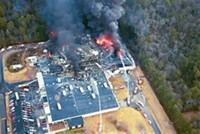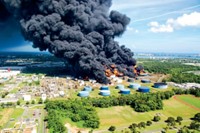Advertisement
Grab your lab coat. Let's get started
Welcome!
Welcome!
Create an account below to get 6 C&EN articles per month, receive newsletters and more - all free.
It seems this is your first time logging in online. Please enter the following information to continue.
As an ACS member you automatically get access to this site. All we need is few more details to create your reading experience.
Not you? Sign in with a different account.
Not you? Sign in with a different account.
ERROR 1
ERROR 1
ERROR 2
ERROR 2
ERROR 2
ERROR 2
ERROR 2
Password and Confirm password must match.
If you have an ACS member number, please enter it here so we can link this account to your membership. (optional)
ERROR 2
ACS values your privacy. By submitting your information, you are gaining access to C&EN and subscribing to our weekly newsletter. We use the information you provide to make your reading experience better, and we will never sell your data to third party members.
Safety
Retreat On Refinery Reform
Safety: Chemical safety board splits on overhaul of California regulations
by Jeff Johnson
January 27, 2014
| A version of this story appeared in
Volume 92, Issue 4

By a divided vote, the Chemical Safety & Hazard Investigation Board (CSB) nixed a staff recommendation for an overhaul of California refinery regulations. As a consequence, California’s potential to be a test bed for a new approach to refinery safety regulations is postponed, if not dashed.
The vote by board members Beth Rosenberg and Mark Griffon opposed that of CSB Chairman Rafael Moure-Eraso and the views of most community members at a crowded, nearly five-hour hearing in Richmond, Calif., on Jan. 15.
The recommendation sprang from CSB’s investigation of an August 2012 accident involving a ruptured pipe at the Chevron refinery in Richmond, which sent 15,000 residents to area hospitals. CSB’s accident report noted that the accident’s cause was a result of a “patchwork” of inadequate U.S. refinery regulations and urged a sweeping change in those regulations (C&EN, Dec. 23, 2013, page 7).
Key among the report recommendations was that California serve as a model for a new “safety case” approach to regulating the state’s 15 refineries. Used in the U.K., Australia, and Norway, the safety case approach puts the regulatory onus on companies, requiring them to develop their own process safety requirements that are to be closely overseen by a state regulator.
The dissenting board members urged in a motion that CSB further study refinery regulatory options.
It is extremely rare that CSB splits on votes, and it is unclear what happens next.
In a statement, CSB said, “We are in the process of reviewing the motion adopted at the public meeting.” Meanwhile, CSB said, it will continue to support California’s efforts to reform refinery safety regulations.
“Our goal is to make the report stronger in short order,” said Rosenberg as the hearing ended, but Moure-Eraso appeared visibly distressed, calling the vote a “missed opportunity.”
Public comments given at the meeting were also sharply split, with Richmond Green Party Mayor Gayle McLaughlin urging CSB to move ahead and U.S. Rep. George Miller (D-Calif.) promoting more study. Local unions backed the safety case approach, and the national United Steelworkers opposed implementation. Industry also opposed the approach.




Join the conversation
Contact the reporter
Submit a Letter to the Editor for publication
Engage with us on Twitter